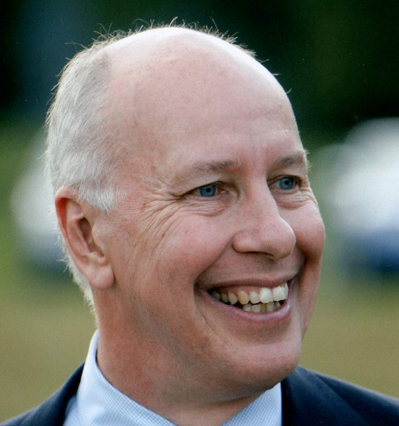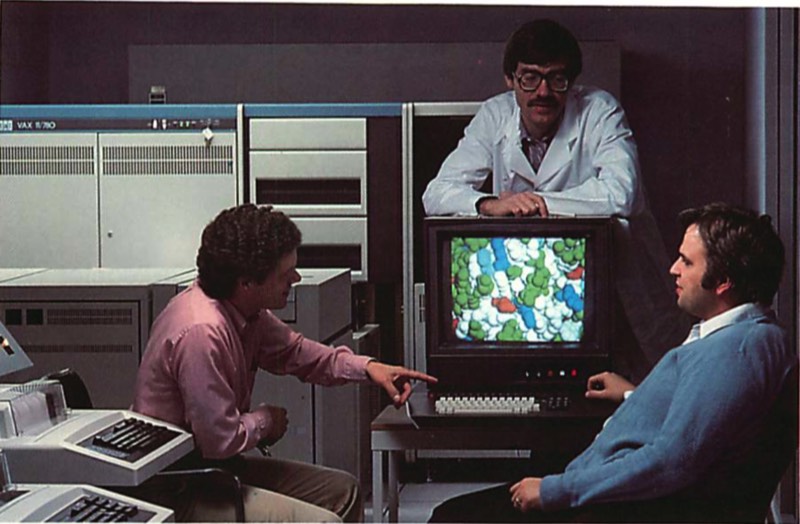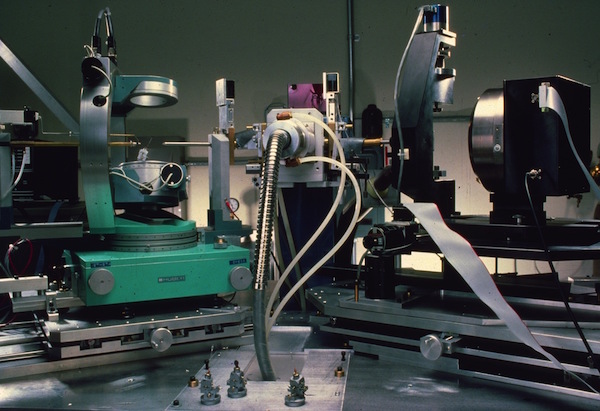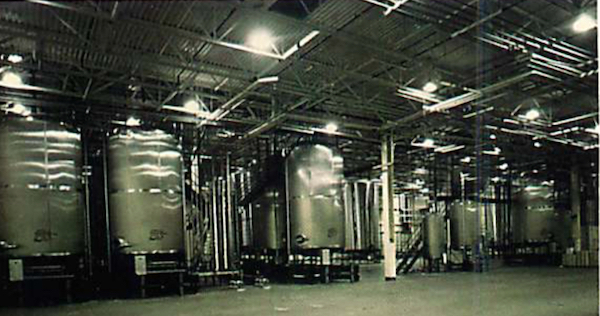Genex: The Early Days (1983-1984)
Genex was one of the first biotechnology companies, along with Genentech, Genencor, Amgen, and Cetus. Genex’s focus was on industrial applications of biotechnology.
A recent picture of Kevin Ulmer, who originated the idea for the Genex Protein Engineering Division and wrote a seminal paper in Science in 1983 that proved prescient for a newly emerging field of science.
Jeff Reidler, Jim Matthew and and Doug Ohlendorf overlooking Genex’s DEC VAX780 computer installation and computer graphics systems for molecular visualization and protein engineering.
The X-ray installation at Genex that included an Elloitt GX21 rotating anode X-ray generator, a 4-circle diffractometer and a prototype Xentronics area detector.
Genex Paducah Facility. Genex invested heavily in the conversion of an existing Seagrams mixed cocktail production plant, located in Paducah Kentucky, into a bioreactor facility that used immobilized enzyme bed reactors to make the amino acid phenyalanine. Phenyalanine was used as a feedstock for the manufacture of aspartame, a high potency sweetener being manufactured by G.D. Searle.
I had returned to Tucson in the fall of 1982 after my sabbatical year working among the WERMS group members at Yale. By coincidence, I noticed an ad in the back of Science for a position to build a new protein engineering group at a biotech startup called Genex Corporation in Gaithersburg MD. Some perspective on the position was given in a Science article entitled “Protein Engineering” written by Kevin Ulmer, who was associated with the company and had been the principle architect of a deal brokered between Genex and Bendix Corporation to build Genex’s protein engineering capability over a five-year period. Kevin’s article mentioned advances in protein crystallography (particularly the use of 2-dimensional area X-Ray detectors) and computer graphics, that together with tools of recombinant DNA technology, would enable the development of engineered proteins for industrial and biomedical purposes.
Genex had been founded by Princeton-based venture investor Robert Johnston and Leslie Glick, Genex’s CEO. It was among the first biotechnology companies, a group that included Genentech, Cetus, and Amgen. Genex was focused on industrial applications of biotechnology. The company’s initial work involved the development of immobilized enzyme bed reactors for the production of phenyalanine. Phenyalanine was the limiting feedstock in the production of the artificial sweetener aspartame, which was commercially developed by G.D. Searle, and was undergoing rapid market growth as a sweetener in zero calorie soft drinks and other low-calorie food applications.
The foray into the then nascent field of protein engineering represented a new opportunity for Genex that was well-funded through the collaborative deal with Bendix Corporation. Following my move to Gaithersburg MD, I proceeded to assemble the key technical competencies to build an effective interdisciplinary group in this new area of science. Some key members of the group included Pat Weber, Doug Ohlendorf, Barry Finzel, Andy Howard, Bob Ladner, and Jim Matthews. Pat, Doug and Barry were accomplished protein x-ray crystallographers. Pat and Barry had both worked on structures solved using X-ray data collected from 2-dimensional area detectors developed by the Xuong lab at UCSD (later to be commercialized as ADSC by Xuong and Ron Hamlin). Kevin Ulmer had made an arrangement to help development of the Xentronics 2D area detector being developed by Ron Burns in collaboration with Don Wiley’s group at Harvard. At that time, there were no satisfactory data reduction programs available to process data from the Xentronics device, so we hired Andy Howard, who had worked with Xuong in San Diego on the ADSC detector software, to develop a data reduction and processing software package for the Xentronics. This effort both drove the immediate Genex structure determination efforts and produced the widely used and distributed XENGEN data reduction software package. Bob Ladner, who had recently finished a postdoc at the MRC lab in Cambridge came on board to head the computer graphics effort, which was seen as a key component to the overall protein engineering effort. In those early days, effective use of the then state-of-the-art Evans and Sutherland graphics systems required quite a bit of machine-specialized coding expertise, a far cry from today’s sophisticated molecular graphics packages with streamlined and intuitive graphical user interfaces. I had met and collaborated with Jim Matthews while on sabbatical at Yale, and he joined the Genex group to provide both experimental and computational biophysics support to the group.
We rapidly established the group’s physical infrastructure (computers, computer graphics, X-ray data collection facilities, protein chemistry resources, etc.) and operating framework. We pursued a number of structural studies based both on fundamental issues of protein stability and practical applications related to high performance industrial enzymes, initially focused on enhanced proteases for laundry detergent applications.
Meanwhile, the CEO of Bendix, William Agee, decided to initiate a hostile takeover of the Martin Marietta Corporation. The Board of Directors of Martin initiated a Pac-man defense, in which the threatened company simultaneously tries to acquire the hostile suitor by buying stock in the public market. The defense was successful, and the situation was ultimately only resolved by Bendix being taken over by Allied Corp.
When the dust settled and an Allied management team visited Genex, they did not know what to make of the Bendix-initiated protein engineering collaboration. The program still had a couple years to run under the original Bendix contract, although its objectives were far outside Allied’s existing business activities. At this time, Genex was heavily investing in the conversion of a former-Seagrams canned cocktail facility located in Paducah Kentuky to scale its phenyalanine production capabilities, but was experiencing unexpected and costly technical difficulties bringing the plant on line. Given the opportunity, Genex management decided that the best solution was to cash out of the Bendix deal with Allied and to use the proceeds to support the Paducah efforts.
Genex had been depending on continued and expanding demand from G.D. Searle for the output of its phenylalanine production. However, it turned out that Searle had made alternative arrangements with the Japanese supplier Aginimoto and had been using Genex as a contingency partner while patiently awaiting the Aginimoto production capacity coming on line. Consequently the company was left in a difficult cash flow position, where the Protein Engineering Division was going to be required to find alternative sources of funding. This precipitated the exit of many members of the PE group, ultimately to reform at DuPont Central Research in Wilmington DE.
I do remember Bob Johnston coming through one day to showcase the Protein Engineering Division to a visitor who turned out to be George Rathman, the then CEO of Amgen. At the time Amgen was focused on the development of a novel biochemical process for the production of indigo dye. George was duly impressed by the capabilities that we had built at the Genex Protein Engineering Division and suggested to Bob that the two companies should be combined. Bob turned down the offer.
Genex had been founded by Princeton-based venture investor Robert Johnston and Leslie Glick, Genex’s CEO. It was among the first biotechnology companies, a group that included Genentech, Cetus, and Amgen. Genex was focused on industrial applications of biotechnology. The company’s initial work involved the development of immobilized enzyme bed reactors for the production of phenyalanine. Phenyalanine was the limiting feedstock in the production of the artificial sweetener aspartame, which was commercially developed by G.D. Searle, and was undergoing rapid market growth as a sweetener in zero calorie soft drinks and other low-calorie food applications.
The foray into the then nascent field of protein engineering represented a new opportunity for Genex that was well-funded through the collaborative deal with Bendix Corporation. Following my move to Gaithersburg MD, I proceeded to assemble the key technical competencies to build an effective interdisciplinary group in this new area of science. Some key members of the group included Pat Weber, Doug Ohlendorf, Barry Finzel, Andy Howard, Bob Ladner, and Jim Matthews. Pat, Doug and Barry were accomplished protein x-ray crystallographers. Pat and Barry had both worked on structures solved using X-ray data collected from 2-dimensional area detectors developed by the Xuong lab at UCSD (later to be commercialized as ADSC by Xuong and Ron Hamlin). Kevin Ulmer had made an arrangement to help development of the Xentronics 2D area detector being developed by Ron Burns in collaboration with Don Wiley’s group at Harvard. At that time, there were no satisfactory data reduction programs available to process data from the Xentronics device, so we hired Andy Howard, who had worked with Xuong in San Diego on the ADSC detector software, to develop a data reduction and processing software package for the Xentronics. This effort both drove the immediate Genex structure determination efforts and produced the widely used and distributed XENGEN data reduction software package. Bob Ladner, who had recently finished a postdoc at the MRC lab in Cambridge came on board to head the computer graphics effort, which was seen as a key component to the overall protein engineering effort. In those early days, effective use of the then state-of-the-art Evans and Sutherland graphics systems required quite a bit of machine-specialized coding expertise, a far cry from today’s sophisticated molecular graphics packages with streamlined and intuitive graphical user interfaces. I had met and collaborated with Jim Matthews while on sabbatical at Yale, and he joined the Genex group to provide both experimental and computational biophysics support to the group.
We rapidly established the group’s physical infrastructure (computers, computer graphics, X-ray data collection facilities, protein chemistry resources, etc.) and operating framework. We pursued a number of structural studies based both on fundamental issues of protein stability and practical applications related to high performance industrial enzymes, initially focused on enhanced proteases for laundry detergent applications.
Meanwhile, the CEO of Bendix, William Agee, decided to initiate a hostile takeover of the Martin Marietta Corporation. The Board of Directors of Martin initiated a Pac-man defense, in which the threatened company simultaneously tries to acquire the hostile suitor by buying stock in the public market. The defense was successful, and the situation was ultimately only resolved by Bendix being taken over by Allied Corp.
When the dust settled and an Allied management team visited Genex, they did not know what to make of the Bendix-initiated protein engineering collaboration. The program still had a couple years to run under the original Bendix contract, although its objectives were far outside Allied’s existing business activities. At this time, Genex was heavily investing in the conversion of a former-Seagrams canned cocktail facility located in Paducah Kentuky to scale its phenyalanine production capabilities, but was experiencing unexpected and costly technical difficulties bringing the plant on line. Given the opportunity, Genex management decided that the best solution was to cash out of the Bendix deal with Allied and to use the proceeds to support the Paducah efforts.
Genex had been depending on continued and expanding demand from G.D. Searle for the output of its phenylalanine production. However, it turned out that Searle had made alternative arrangements with the Japanese supplier Aginimoto and had been using Genex as a contingency partner while patiently awaiting the Aginimoto production capacity coming on line. Consequently the company was left in a difficult cash flow position, where the Protein Engineering Division was going to be required to find alternative sources of funding. This precipitated the exit of many members of the PE group, ultimately to reform at DuPont Central Research in Wilmington DE.
I do remember Bob Johnston coming through one day to showcase the Protein Engineering Division to a visitor who turned out to be George Rathman, the then CEO of Amgen. At the time Amgen was focused on the development of a novel biochemical process for the production of indigo dye. George was duly impressed by the capabilities that we had built at the Genex Protein Engineering Division and suggested to Bob that the two companies should be combined. Bob turned down the offer.



